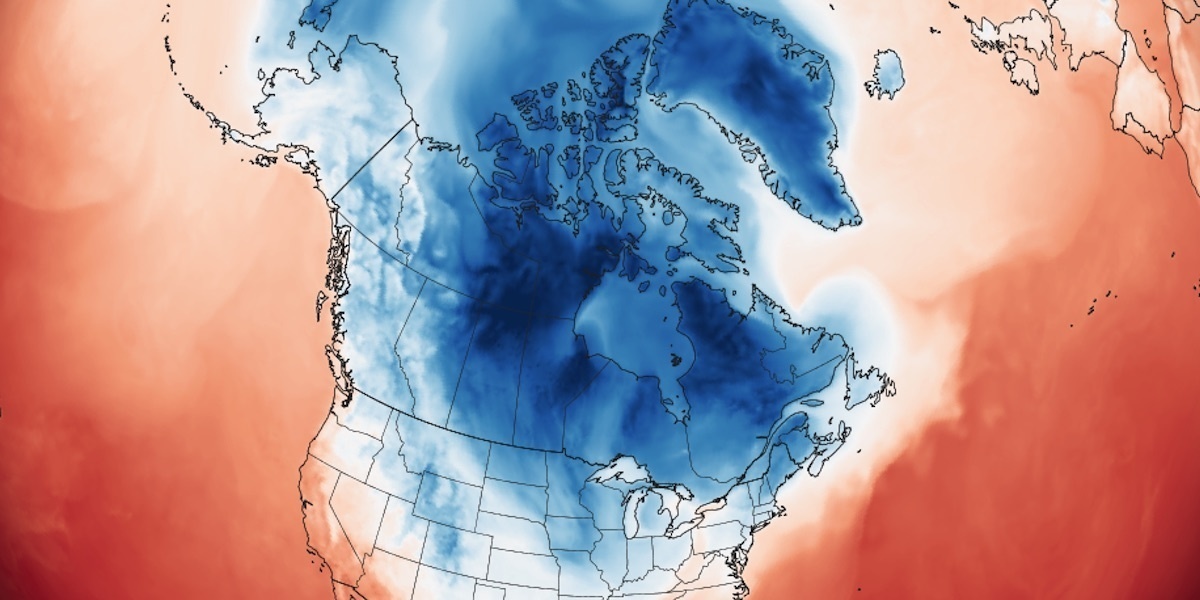

Air temperatures at 4 a.m. EST on Jan. 29, 2019. NASA Earth Observatory
During bouts of extreme weather, we always turn to our beloved meteorologists to analyze, forecast and report these events.
So you know it’s really cold outside when trusted weather experts, like Minneapolis’s Chris Shaffer of WCCO-TV, dedicate The Weeknd’s “Can’t Feel My Face” to Mother Nature amid temperatures that feel like the negative 30s, 40s and 50s.
Right now I am singing that boss song from @theweeknd to Mother Nature. I CAN'T FEEL MY FACE WHEN I'M WITH YOU! pic.twitter.com/4bjpzROOqJ
— Chris Shaffer (@WCCOShaffer) January 29, 2019
As the deadly polar vortex grips much of the U.S., cities are clocking temperatures lower than most of Antarctica, Insider reported.
For instance in La Crosse, Wisconsin, temperatures dropped to -30°F at 5.20 a.m. on Wednesday, according to the local National Weather Service (NWS), and it may be the office’s “all-time coldest record.”
Meanwhile in the South Pole, AccuWeather data showed that only one weather station had a lower temperature than La Crosse around the same time, Insider noted. All the other weather stations on the continent recorded much warmer temps.
We have officially hit -30 here at the NWS La Crosse office as of 520 a.m. The wind chill is -54. Be sure to dress appropriately if you're heading out for the day. pic.twitter.com/y80sMDZM7y
— NWS La Crosse (@NWSLaCrosse) January 30, 2019
Sure, Antarctica is in the southern hemisphere, meaning it’s in the middle of its summer. But cities like Chicago are forecast to be in the 25-below range on early Thursday, so it could be colder than the North Pole and Alaska, USA Today reported.
“The Arctic Ocean—including the North Pole—will probably be around 20 below,” said weather.us meteorologist Ryan Maue, according to USA Today.
https://twitter.com/RyanMaue/statuses/1090299898963152899
Meteorologist Jen Carfagno, the host of AMHQ at The Weather Channel, noticed that it’s so cold that NWS Lincoln ran out of colors for its weather map.
When the forecast is so cold you need a new color table ?? https://t.co/TvyxoeWVjs
— Jen Carfagno (@JenCarfagno) January 29, 2019
WDRB meteorologist Rick DeLuca of Louisville, Kentucky chimed in with a big “NOPE!” about the -60°F wind chill in Grand Forks, North Dakota on Tuesday.
“But at least it’s a dry cold,” NWS Twin Cities joked back.
But at least it's a dry cold
— NWS Twin Cities (@NWSTwinCities) January 29, 2019
DeLuca also tweeted a photo of a shirt that literally froze from Louisville’s blistering wind chill.
FROZEN SHIRT: Wind Chill Advisories and laundry night don't mix well. #snowfox pic.twitter.com/5xkb1DDc1M
— Rick DeLuca (@RDeLucaWX) January 30, 2019
Andrew Buck Michael, meteorologist for Good Day Columbus, reminded us that many Midwesterners would probably rather be in Florida right now, where it feels 131 degrees warmer in Key West compared to Park Rapids, Minnesota.
CHECK THIS OUT! The current "feels like" temperature is -65 in Park Rapids, MN with the wind chill, but it feels 131 degrees warmer in Key West, with the heat index currently at 65. THAT. IS. INSANE!!!! #PolarVortex2019 pic.twitter.com/i50ohIMwQZ
— Andrew Buck Michael (@AndrewWSYX6) January 30, 2019
Jokes aside, these snow squalls and wind chills can be very dangerous. Meteorologist John Kassell of Akron, Ohio shared a recent warning from NWS Des Moines telling residents that the weather will be “the coldest air many of us will have ever experienced” and for people to “avoid taking deep breaths, and minimize talking” while outdoors.
Unfortunately, many Americans will continue to freeze for the next few days. Air temperatures in parts of the continental U.S. could break all-time record lows for Jan. 30 and 31, NASA wrote in a blog post on Tuesday, adding that at least 90 million Americans could experience temperatures at or below zero degrees Fahrenheit, citing data from the NWS.
Extreme cold is so dangerous and life-threatening across the Upper Plains and Midwest that folks are advised to avoid taking deep breaths and minimize talking. Don't say that up advisory every day! pic.twitter.com/KfFrC4BWwQ
— John Kassell (@wxkassell) January 30, 2019

 233k
233k  41k
41k  Subscribe
Subscribe 